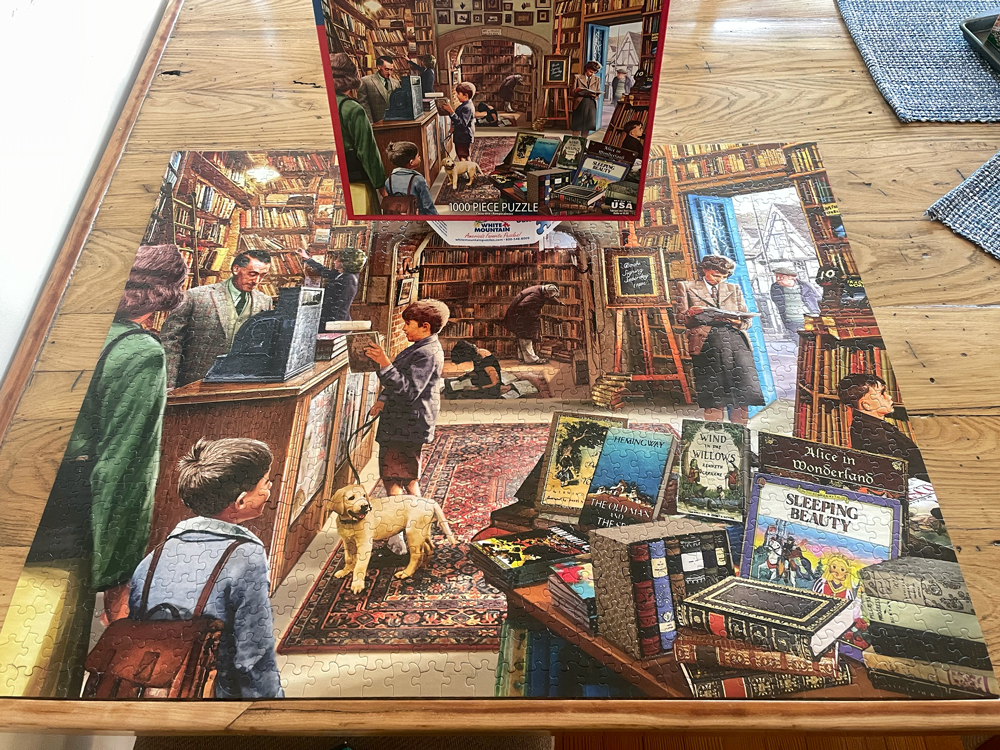This time of year, when winter and darkness force us toward inside entertainment, I take both comfort and challenge from a very un-competitive shoreside activity: assembling jigsaw puzzles. Here’s why I find moving small pieces of cardboard around a table so satisfying.
1. There’s a place for each piece; we just have to find it
Much about today’s world doesn’t seem to fit or make much sense. There’s comfort in knowing that focus and time will eventually turn a heap of chaos into the promised picture.

2. It forces me to differentiate between subtle details
When I first dump all the pieces out of the box, only the obvious colors stand out—so, once the edge is mostly complete, that’s where I start. But once that green coat, yellow lab puppy, and all those readable letters on the largest books are in place, I have to train my eye to pick out much more subtle differences. Ah—those more blurry book spines are shelved in the top left corner! And that swirl of plaid is too square to be part of the rug underfoot; it belongs to the owner’s suit jacket.
3. It provides a tactile reward
No amount of creative computer time (including Wordle) can replace the physical satisfaction of snapping a piece into its proper place—especially when it’s a piece I’ve been specifically searching for.
4. I hear my Mom
Every winter visit to my parents’ house used to include working on a jigsaw puzzle with my mother, and her patience and determination were legendary even as her strength waned. I frequently hear her voice in my head, trying to describe a color or placement—and my jigsaw “rules” all come from her; build the framework first, put together the obvious sections, and trust that time and patience and attention to detail will bring the rest into position, piece by piece.
5. Everything’s in the box
In 2009, I told you that I do my best writing when “I focus on the little pieces, trusting that an overall shape and texture will eventually appear.” (Read more in What’s a Rough Draft?) In 2015, a change in my work routine inspired a post about how seemingly insigificant details really represent life choices. Unlike novels or life, I know before I begin that a jigsaw puzzle already includes all the pieces I really need—and nothing more.
Got a favorite off-season habit? Share it in the comments below, or send me an email. I read every single one, with gratitude.
Always fun to see the coming together.
And thanks for not hovering!
Jigsaw puzzles were a common activity in my family, too! I still love them.
Happy to pass along the ones I complete if you’re interested!
Jigsaws bring the family together and at times teach grace and forgiveness.
Our family has done a jigsaw puzzle the past several years at Christmas. This past Christmas my wife and I started and completed a 500 piece puzzle before the rest of the family arrived, so when everyone arrived she got out a 1000 piece puzzle for the family to work on. The 1000 piece puzzle was 90% shades of blue and the pieces were almost all identical in shape and size except for the edges. The saving grace was the back side of the puzzle was stamped in sections with letters so if you had sections of several pieces put together you could verify everything was correct by flipping a section over and look to see if the letters matched and aligned. Long story short, my mom and my sister worked on it about 20 hours each over 3 days and had it 95% completed when the went to bed one night. The following morning they awoke to learn my 2 year-old grandson had pulled the puzzle off the table and managed to reduce it to 1000 pieces again. Needless to say there was much disappointment, but all was forgiven.
Keith, wow thanks for this story. Laughed out loud when I got to the grandson part! I’ve never come across a puzzle with letters on the back, but I have suffered through several that were all just subtle shades of blue. I recently discovered Buffalo puzzles, very good quality and lots of variety in colors/shading/shapes. Thanks again for the laugh and happy puzzling.
Your discussion of jigsaw puzzles, in a way, suggests an effective problem solving strategy, especially for writers. Writing a book is like putting a jigsaw puzzle together in your head and then putting it down on paper or in a word document. All the pieces are in your mind including the ones that are the exact fit for every part of your book. Jigsaw puzzles are a way putting the unseen into perfect visibility. So much of what a writer sees is invisible until brought into the clear vision in their completed book.
Larry, absolutely. The big difference is that jigsaw puzzles have already weeded out all the unnecessary bits and bobs that are hard to spot in our writing! Thanks for the comment.